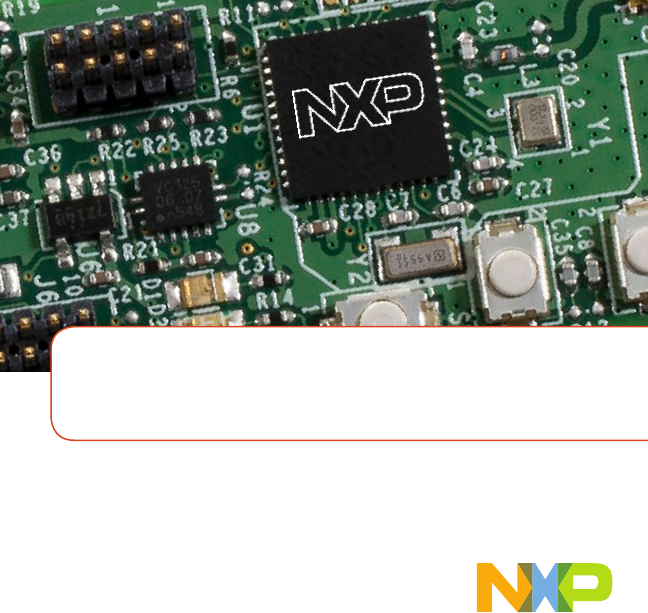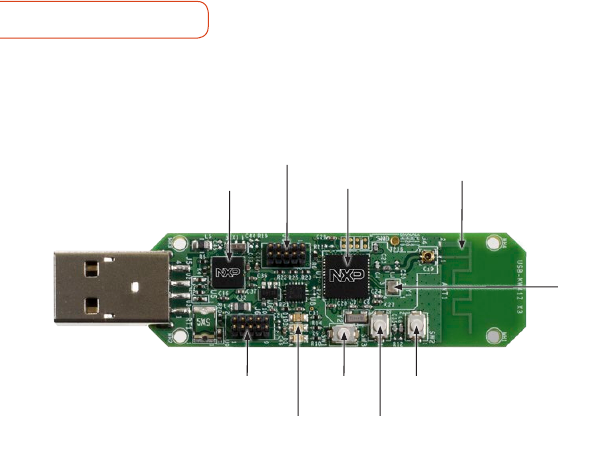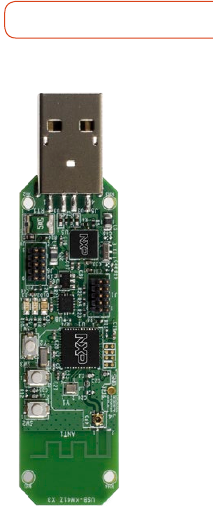NXP Semiconductors USBKW41Z USB-KW41Z Packet Sniffer USB Dongle User Manual USB KW41Z Quick Reference Guide
NXP Semiconductors USB-KW41Z Packet Sniffer USB Dongle USB KW41Z Quick Reference Guide
Contents
- 1. Quick Start Guide
- 2. Users Manual
Quick Start Guide

Quick Start Guide
USB-KW41Z
FREEDOM DEVELOPMENT PLATFORM

2
GET TO KNOW THE USB-KW41Z
Quick Start Guide
Figure 1: USB-KW41Z Board Components
Printed
Meander
Antenna
32 MHz
Crystal
OpenSDA
MCU
KW41Z
SWD KW41Z
MCU
OpenSDA
Reset
Application
Button
KW41Z
Reset
OpenSDA
SWD
Power and
Application
LEDs

3
HOW TO GET STARTED
www.nxp.com
1. Plug in the USB-KW41Z board to a PC.
A green power LED and a red application
LED will illuminate.
2. USB-KW41Z comes pre-programmed with
a Bluetooth Smart
®
sniffer application.
3. Explore more out-of-box demos and download software
and tools on www.nxp.com/USB-KW41Z/startnow.
4. Enjoy your design freedom with the USB-KW41Z.

SUPPORT
Visit www.nxp.com/support for a list
of phone numbers within your region.
WARRANTY
Visit www.nxp.com/warranty for
complete warranty information.
www.nxp.com
NXP and the NXP logo are trademarks of NXP B.V. All other product or service names are the property of
their respective owners. © 2016 NXP B.V.
Document Number: USBKW41ZQRG REV 0
Agile Number: 926-29102 REV A
Get Started
Download installation
software and documentation
under “Jump Start Your Design”
at www.nxp.com/usb-kw41z.
FCC NOTE:
This device complies with Part 15 of the FCC Rules.
Operation is subject to the following two conditions: (1) this device may not
cause harmful interference, and (2) this device must accept any interference
received, including interference that may cause undesired operation.
Any Changes or modifications not expressly approved by the party
responsible for compliance could void the user's authority to operate the
equipment.
This equipment has been tested and found to comply with the limits for a Class
B digital device, pursuant to part 15 of the FCC Rules. These limits are
designed to provide reasonable protection against harmful interference in a
residential installation. This equipment generates, uses and can radiate radio
frequency energy and, if not installed and used in accordance with the
instructions, may cause harmful interference to radio communications.
However, there is no guarantee that interference will not occur in a particular
installation. If this equipment does cause harmful interference to radio or
television reception, which can be determined by turning the equipment off and
on, the user is encouraged to try to correct the interference by one or more of
the following measures:
This equipment has been tested and found to comply with the limits for a Class
B digital device, pursuant to part 15 of the FCC Rules. These limits are
designed to provide reasonable protection against harmful interference in a
residential installation. This equipment generates, uses and can radiate radio
frequency energy and, if not installed and used in accordance with the
instructions, may cause harmful interference to radio communications.
However, there is no guarantee that interference will not occur in a particular
installation. If this equipment does cause harmful interference to radio or
television reception, which can be determined by turning the equipment off and
on, the user is encouraged to try to correct the interference by one or more of
the following measures:
This equipment complies with FCC radiation exposure limits set
forth for an uncontrolled environment. End users must follow
the specific operating instructions for satisfying RF exposure
compliance. To maintain compliance with FCC RF exposure
compliance requirements, please follow operation instructions
as documented in this manual. This transmitter must not be colocated
or operating in conjunction with any other antenna or
transmitter. The availability of some specific channels and/or
operational frequency bands are country dependent and are firmware
programmed at the factory to match the intended destination.
The firmware setting is not accessible by the end user.